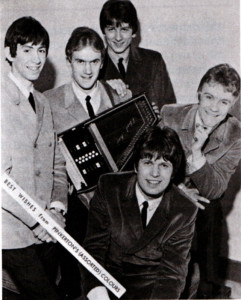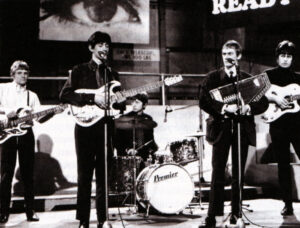
Some said he had the looks of Elvis. Others reckoned he hadn’t changed all that much since he’d sung in the village church choir. Then there were a few, less charitable souls with long memories, who could readily recall the days when young feller-me-lad had been better known for scrumping apples or shooting his catapult.
But none of that mattered any more. When Tony Newman strode through the village these days, people crossed the road to shake his hand. For our Tony was now a pop star – the first, and quite probably the last, that the Warwickshire village of Churchover was ever likely to produce.
So when he strode down School Street on his way to the Greyhound Inn dressed in a three-quarter length suede coat and purple bell-bottoms, all topped off with a cockerel’s comb of glossy brown hair, everyone wanted to make his acquaintance.
It was early spring in 1966 and Tony’s group was riding high. Pinkerton’s Assorted Colours, formerly The Liberators, had provided a perfect vehicle for the aspiring young songwriter. One of Tony’s creations, titled Mirror, Mirror had sold enough records to merit an airing on Britain’s first mainstream music programme. Top of the Pops. In fact, it reached number eight in the charts.
I remember the occasion as if it had been yesterday. I’d just arrived home from work when my mother greeted me at the door saying that Tony was on television and I had to ‘come quick and see’.
And sure enough, there he was in all his sartorial splendour, undimmed by the limitations of the 12-inch Baby Bush television. Tony was taking lead vocals, while Sam ‘Pinkerton’ Kemp was on autoharp, an instrumental innovation that gave the group a most distinctive sound.
It was almost dark on that March evening and, peering across School Street, I noticed a tiny black and white television twinkling in every front room. Churchover was paying homage to its only famous son and wasn’t going to miss a single moment. What a to-do, indeed. To think that our Tony was famous and on the telly!

Mirror, Mirror remained in the charts for some time and received constant airplay on Radio Sutch and Radio City, pirate stations owned by pop impresario Reg Calvert.
There was a link, of course, for Calvert ran a pop stable of would-be stars from a rambling manor house in the village of Clifton, near Rugby. Pinkerton’s were one of the jewels in his pop crown – a year earlier, his flagship group The Fortunes had hit the big time with You’ve Cot Your Troubles.
Reg Calvert had visions of emulating the success of Brian Epstein and The Beatles, but it was not to be. He was killed in a mysterious shooting accident in the summer of 1966, the victim of circumstances that remain unclear to this day.
But this was all in the future, and as Tony walked down the village street in all his Carnaby Street finery, he must have thought there was now no looking back.
I have many happy memories of Tony but the one that most readily springs to mind is the generosity of spirit he showed towards me when I was laid up at home after breaking my leg in a road accident. Because of my injuries, I was confined to a bed in the front room. When Tony heard of my plight, he not only dropped by but also brought along his guitar, too. We spent many a happy hour playing together and he even showed me the chords of his great creation, Mirror, Mirror. I felt so honoured that a pop star should want to call at my house –
despite the stardom, he still had plenty of time for village lads like me.
On another occasion, I recall him walking into the bar of the Greyhound Inn. The villagers were sat around the tables in their cloth caps, mufflers and shawls, sipping mild and stout as they had done for years. Tony resembled Joseph in his amazing technicolor dream coat, about as stark a contrast imaginable – yet no one raised an eyebrow, for it was only our Tony. Just how-do, how-you doin’, Tony?
Pinkerton’s Assorted Colours’ star rose high in the heavens but then gradually burned out. The group never again enjoyed success on such a scale and in 1968 changed their name to The Flying Machine. The boys went on to achieve a million-seller in America with Smile A Little Smile For Me, and although this was not Tony’s song, his distinctive vocal style is instantly recognisable. The group disbanded in the early 1970s.
These days, he performs as a duo, occasionally reforming Pinkerton’s for charity events in the Rugby area. I visit Churchover every year and always delight in walking down School Street and past my old home where Tony and I played Mirror, Mirror aII those years ago. Then it’s on to the old Manor House. This old Georgian farmhouse had been divided into flats in the 1960s, and it was here that Tony wrote his hit song.
And so I pause for a moment and cast my mind back four decades to that memorable spring evening in 1966 when the whole village was glued to television sets, worshipping at the feet of a cuban-heeled Tony Newman – the country lad who became a pop star.
John Phillpott, Worcester • For more about Reg Calvert visit www.offshoreradio.co.uk/djsc.htm








